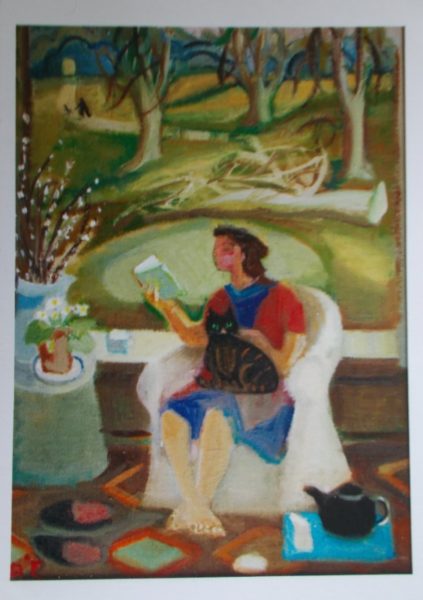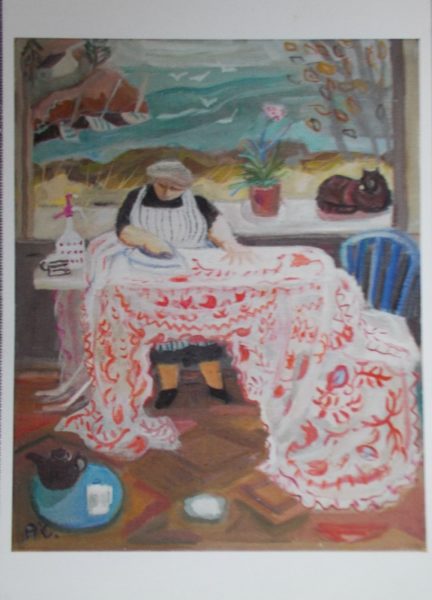A glorious few days in a sunny Yorkshire saw us ferreting around in remarkable churches, strolling through surprisingly uncrumbly abbey ruins (Whitby Abbey and Rievaulx), wandering wide eyed in and around the very best of Elizabethan prodigy palaces (Hardwick Hall) and visiting one of the finest seaside towns that the north has to offer (Whitby). Unfortunately for the seaside bit, with Covid restrictions eased, foreign travel reduced and school half term holiday, England and his wife, plus family and dogs had also decided to go coastwards at the same time. Love of my fellow man was put to the severest of tests and I had to remind myself not to be hasty to judge others just because they too had given in to the same urge to rush to the seaside as we had. Others in our party who had been to Whitby before, lamented that so many visitors overwhelmed a what was essentially an overgrown fishing village, whose ruined abbey happened to have been the touch paper to the flame of inspiration that fired Bram Stoker to write Dracula. (The abbey is 199 steps up from the harbour – or for the lazy, infirm or spoonfed (us) some 15-20 minutes away in the coach!) Sadly, the little museum of jet artefacts and the handful of craftsmen working this semi precious stone which outcrops locally had few visitors, though at least one in our party bought a substantial piece set in silver hanging from a silver chain. We lingered in Whitby no more than we had to, retreating inland and back to the attractions of the sedate little market town, Pickering, our home for the week. Fortunately, the hotel, built around a Georgian manor house had a stone courtyard opening into a semi-meadow lawn of not overly manicured grass. Some sat chatting with drinks in the courtyard while others, like my husband, took themselves off to seats under trees to enjoy a book and a pipe. Birds sang and insects thrummed their way from flower to flower. Daylight extended long into the evening and even the nights were never really dark. Little can match early June in England when the weather is on your side. Coats and jackets stayed in the hotel. At night windows were left open and no doors banged nor curtains fought to get loose of their moorings. All rather wonderful.

Anthea Craigmyle: Woman reading
Then home. I’d packed knitting, a cardigan to finish and a new one to begin, but little was done. Back to my sewing position by my window I picked up the cardigan to add the buttons but was distracted by two postcards I have tucked into the frame of a little Venetian mirror in our bedroom. They came from the same friend years apart and it was only when I received the second card that I looked at both of them properly. (Coincidentally, today is my friend’s birthday.) The woman engrossed in her book came first and how I relate to those broad Tudor feet, unsocked, unshod, toes free of restriction. The cat has a fierce look I recognise of one not truly settled as the woman, trying to maintain one handed hold on her book, attempts a half hearted stroke, while at the same time probably hoping the large tabby will soon jump off so she can access the tea in the substantial tea pot at her feet. The book must be good as she has her back to a vast window through which trees writhe, a pond sits glassy with ice and a curling pathway carries figures hurrying towards a lighted doorway. Outside suggests winter. Inside are bare legs and short sleeves, spring flowers and pussy willow twigs. Perhaps the backdrop is a painting, not a window. The painting’s title ‘Girl reading, last light’ suggests the window option – perhaps before 4pm on a late winter/early spring evening. Inside must definitely be very warm to account for the bare limbs – surely such a large window must be triple glazed or the central heating must be working overtime. Curious.

Anthea Craigmyle: Woman ironing a Russian Tablecloth
Card number two is of a similar composition. Here too, half the picture shows a very painterly view through the window and once again, this too could be a painting. This woman is deep in concentration as she grapples with ironing a large unwieldy tablecloth. Quietly domestic, she has her back to the window; in contrast nature beyond the window is full of bluster and action. The cat is surely the same as in the previous painting and has the same pent up energy as if she won’t be occupying the shelf on which she sits for long. The tea pot is similar, possibly smaller. The rug looks identical – shabbier or less well lit. ‘Ironing the Russian tablecloth’ tells the viewer exactly what to look at. I don’t envy the woman at her ironing but I do rather enjoy watching her doing it.
Both paintings are by Anthea Craigmyle whose life started out in St Nicholas’s vicarage, overlooking the Thames at one end of Chiswick Mall and who died at her home (the last house in Chiswick before you tip into Hammersmith) a few hundred yards away, 83 years later in, 2016. Taught at school by Mrs Henry Moore (Irina), she went on to Chelsea Art School where her tutors included Ceri Richards and Julian Trevelyan. (Later she was to have Trevelyan and his wife Mary Fedden his wife as neighbours when she returned to Chiswick). All are the painters I love, friends and associates of Romantic Moderns as Alexandra Harris terms them in her book of the same name. During the war, Anthea’s mother, Molly Rich filled the vicarage with refugees along with her own children. One of the refugees, a young Austrian called Otto, stayed in touch and in 2013 Anthea collated the letters between him and Molly Rich into a book ‘A Vicarage in the Blitz’. Anthea’s painting on the front cover shows her mother sitting absorbed at a table typing; behind her the Thames flows lustily on while barrage balloons fly over Fuller’s Brewery. Once again the woman is completely absorbed with the task in hand and has her back to the world – even when that world is one where bombs are dropped and buildings go up in flames! Now there’s a role model!

8 Comments
A role model indeed, especially as I am finding that level of concentration rather difficult at present. I do rather envy you your trip, and especially the hotel with the stone courtyard!
It was lovely to get away – a holiday postponed from last year.
I’m sorry to hear you’ve been finding concentration a bit of a trial Rachel. I’m sure you’re not the only one. Most of us feel a bit shaken up and swished around in these peculiar times.
For the time being, be self indulgent and just do what you enjoy most.
It comes and goes. I do my best!
I’m sure you do – just don’t be afraid to be indulgent towards yourself.
Fascinating art indeed – so individual! I love the ironing one especially. Your trip sounds wonderful, despite the crowds.
ceci
Thank you Ceci. It was a lovely trip in which everything – apart from the crowds in Whitby – was as good as you could wish it to be. Th organisers had worked hard to persuade churches worried by the restrictions to open to us and to find alternatives when persuasion proved futile. That we missed out on King Richard III’s final resting place but took in Hardwick Hall instead worked really well for me as HH is one of my very favourite places!
That still sounds like a lovely trip despite the crowds. This painter is fascinating. I wonder why she worked through that theme of domestic concentration with a lively world outside. Maybe the key is in the last painting you describe.
It was a lovely trip and just what we needed.
I love these paintings of people absorbed in what they’re doing while life around them seems pretty lively and rich and I relate to it. Whenever I go away anywhere I like to spend some time in a chair by a window with a nice view and then ignore the room, the view, other people, etc and settle down with a book. It’s a particularly nice experience to look up from the book and suddenly realise I’m not at home!